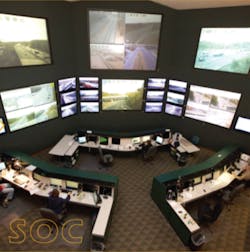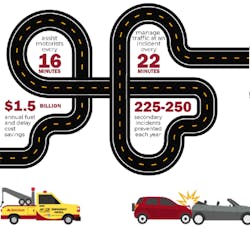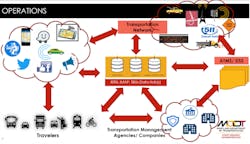Evolution in Traffic Management Systems and Projects
The core mission of departments of transportation (DOTs) at national, state, regional, and local levels involves safe, accessible, reliable, and efficient travel on the transportation systems.
In order to connect people and businesses with opportunities from their origins to destinations, DOTs own, operate, and maintain the transportation infrastructure using a host of business processes, supporting organization structures, and technologies. This article focuses on the transportation systems management and operations (TSMO) aspects of a DOT. Although there are differences in how DOTs across the nation manage and operate their transportation networks, there are many similarities in terms of the challenges and opportunities. The evolution of Maryland’s traffic management systems over the last two and half decades should provide a good context of how the state of the practice has shaped up and where it is headed.
Building Off Traffic Incident Management and Traveler Information System Foundations
Across the urbanized areas in the nation, the transportation system operates at capacity for many hours a day due to ever-increasing travel demand. The rural areas and other areas of the nation experience seasonal and weekend demands on their transportation infrastructure where demand exceeds capacity. Traditional capital projects have typically focused on recurring everyday congestion and long-term capacity needs by adding more lanes, grade separating facilities, etc. However, studies show that more than half of the congestion can be attributed to non-recurrent reasons such as crashes, incidents, bad weather, work zones, special events, etc. When a system is operating at or over capacity, the impacts on non-recurrent events are disproportionately higher. This is where DOTs have established traffic management programs with varying levels of capabilities in traffic incident management, traveler advisory services, and traffic management. Traffic management programs and centers have formally kicked off and evolved in various DOTs due to a variety of reasons, ranging from a high-profile incident that prompted executive action to more organic development resulting from customer needs and the Administration’s systemic priorities.
In Maryland, the inception of the state’s traffic management program—what eventually became the Coordinated Highway Action Response Team (CHART) Program—started as a ‘Reach the Beach’ initiative in the mid ‘80s, focused on improving travel to and from Maryland’s eastern shore. Since that time, CHART has become a statewide, multidisciplinary program responsible for providing traffic monitoring, 24/7 traffic management, traveler information (MD 511) services, and incident response and management services.
CHART is responsible for real-time operations, emergency operations, and special events. The Statewide Operations Center (SOC) serves as the hub for CHART operations and is supported by four Traffic Operations Centers (TOCs) spread across the State. CHART uses a host of tools including traffic speed detectors, traffic counting devices, CCTV cameras, pavement weather sensors, field unit reports, private sector data sources, and crowd-sourced data to monitor travel conditions and report real-time traffic flow to partner agencies, stakeholders, and the traveling public. The traditional focus of CHART has been Traffic Incident Management to coordinate the quick clearance of Maryland’s travel lanes, enhance responder safety, improve interagency communications, and reduce secondary crashes. CHART’s incident management services are a multiagency effort that builds on formal institutional partnership agreements, sound business practices, and well-established standard operating procedures.
CHART emergency traffic patrols and emergency responder technicians work 24/7 to cover 2,000 miles of Maryland roadways and help stranded motorists and support traffic incident management and emergency operations and planned closure activities. Over the years, MDOT SHA has strategically invested in field intelligent transportation systems (ITS) infrastructure, centralized advanced transportation management systems (ATMS), and telecommunications infrastructure to support the CHART program. All these activities have resulted in huge annual user cost savings to the traveling public. For example, in 2019, the CHART program resulted in $1.4 billion user cost savings due to reduced delay, fuel savings, and reduction in secondary incidents.
Transitioning from Operations to Transportation Systems Management and Operations (TSMO)
TSMO has emerged as a formal discipline for transportation agencies throughout the country to effectively manage and operate existing facilities and systems to maximize their full service potential. TSMO strategies aim to address capacity limitations due to recurring and non-recurring congestion through business processes, ITS technologies, and collaboration. TSMO is not a new concept for Maryland, as a strong management and operations foundation has existed for a long time through the CHART program and other multimodal programs. However, one could argue that traditional traffic incident management (TIM) strategies, although very effective, are rather reactive in nature. This is where active traffic management (ATM) strategies come into play. One of the common ATM strategies that DOTs like Maryland use are arterial signal system management for various demand patterns by time of day, day of week, non-recurrent conditions, etc. Strategic deployment of emergency patrols, access to towing services for quick clearance, as well as early coordination of planned closures (work zones, etc.) and special events go a long way to actively manage traffic. ATM strategies like ramp metering, hard shoulder running, reversible lane operations, etc. are more advanced strategies that help in increasing the efficiency of the transportation system. Maryland has had good success with its arterial signal program, reversible lane operations, and has active projects underway to utilize strategies like ramp metering and hard shoulder running on some of its major highways.
As the agency mainstreams and expands ATM strategies throughout the network, the next logical opportunity area is to look at multimodal strategies. For example, urbanized areas like the Baltimore-Washington region that have a robust multimodal transportation network can offer customers travel choices. That is the core of integrated corridor management (ICM) strategies where customers can make a trip from their origin to destinations using multiple modes.
Modern day traffic management systems and centers consist of a complex system of systems with a whole host of agencies, private sector entities, business processes, and technologies that connect and interface to support traffic management activities as people and goods travel through the network. The graphic below shows an example of how DOTs take advantage of a collaborative public-private operations framework to deliver safe, reliable, and efficient travel to their customers.
Moving into Transportation Mobility & Operations Realm
From Maryland’s experience, it is very clear that state DOTs and their traffic management programs are at a unique crossroads. The changing customer needs and expectations calls for a holistic approach to developing and operating the traffic management centers of tomorrow. As the industry gears up for a future with self-driving cars, supporting connected and automated transportation systems would have to be put in place. The DOT traffic management systems have to be strategic to navigate this transition to an automated transportation future with artificial intelligence, machine learning, and supporting technology and business innovations.
DOTs will likely bring in additional ATM strategies on their transportation networks building off TIM foundations. As opposed to a reactive mindset, DOTs will be challenged to rethink the services they have offered with increased focus on efficient management of the transportation system. This will require rethinking how to plan, design, construct, or deploy the next suite of ATM strategies or projects. From Maryland’s experience, the TSMO Strategic Plan, the TSMO Master Plan, and the Telecommunications Plan offer a comprehensive package to reimagine the next-generation traffic management center. Certain organizational changes have been made to integrate arterial operations into the Statewide Operations Center (SOC) to actively manage traffic in real-time. The SOC is being reconfigured to address the changing needs of the agency operational strategies.
In summary, as TSMO continues to become more mainstream across the DOT culture and business processes, the traffic management systems and projects accelerated by technology innovations will play a huge part in accomplishing the DOT mission. As the industry builds from the existing solid traffic management foundations and transitions towards a connected and automated future, it will be all hands on deck—a collaborative framework that has been a core strength of the TSMO community all these years.




